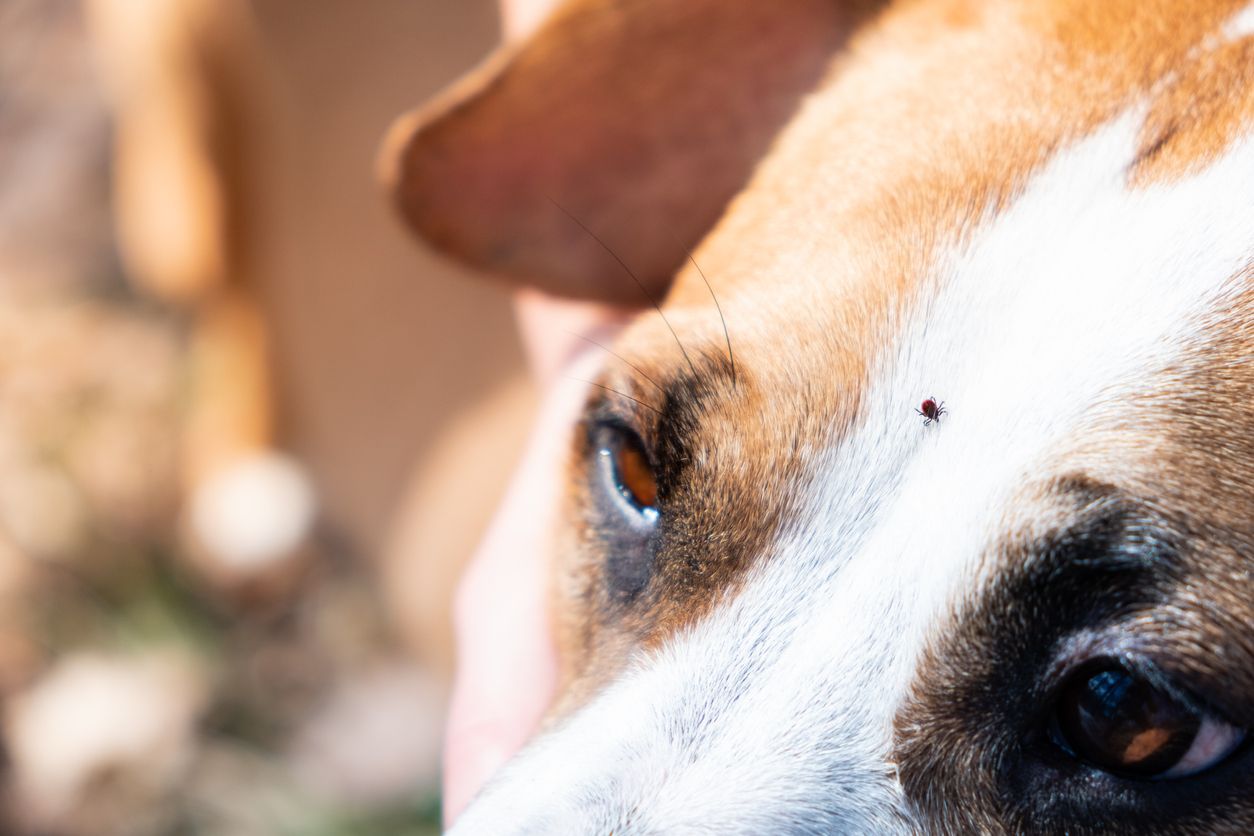Ticks and your dog

Ticks are a growing problem in North America due to climate change, which increases both their geographic range and the duration of their active season. Dogs are susceptible to tick-borne diseases, so it is important to stay up to date with tick prevention recommendations from your veterinarian. Read on to find answers to questions like:
- Can I prevent ticks on my dog?
- What kinds of tick prevention are available for my dog?
- Can my dog have a negative reaction to tick prevention?
- Why are ticks dangerous to dogs?
- I found a tick on my dog. Now what?
Ticks can go dormant in the cold winter months and wake up hungry during tick season when the weather begins to warm. There is also a surge in tick activity in the fall as they prepare to go dormant again. Prevention is essential for dogs, especially in areas where ticks are abundant.
What are ticks?
Ticks are small, parasitic external parasites that ingest blood meals from their hosts. They can affect dogs, cats, humans, and many other animals. They are found worldwide but prefer temperate climates, especially areas with long grass, brush, shrubs, and forested areas. Ticks appear flat when they first attach to a host and become engorged as they feed. They eventually fall off. Infestations can occur when multiple ticks attach and feed on a dog at the same time.
How can I prevent ticks on my dog?
The good news is ticks can be prevented in dogs. The Companion Animal Parasite Council (CAPC) recommends that dogs in high-risk areas stay on tick prevention medication year-round. While ticks can be found worldwide, the Eastern states in the US and Southeast Canada have the highest population of ticks and incidence of tick-borne diseases in North America.
Which tick preventative is best for my dog?
There are oral medications, topical solutions, and tick collars available to protect dogs from ticks. Many tick-preventative medications also protect dogs from fleas, heartworms, and other external and internal parasites. As long as the preventative is FDA-approved and recommended by a veterinarian, the type of prevention is up to owner preference and the pet’s tolerance. Always give size- and species-specific prevention to avoid toxicity or ineffective dosages. Talk to a veterinarian before choosing an over-the-counter option because many of these products are not safe or effective.
Tick collars
Tick collars use pesticides to repel and kill ticks and fleas. They can last multiple months depending on the collar. Collars need to be tight enough to have contact with the skin to work properly. Not all tick collars are created equal. Always consult a veterinarian to make sure the collar you choose is effective and safe for your dog, and keep in mind that some types of tick collars on your dog can be risky for any cats you might also have.
Oral tick prevention
Oral tick prevention is typically given monthly in a pill, tablet, or treat. They do not prevent tick bites, but oral prevention kills a tick quickly to prevent it from feeding and spreading disease.
Topical tick prevention
Topical preventatives are given every one to three months depending on the type or brand. They come in single doses that are placed on the skin between the shoulder blades where the preventative cannot be licked off. Topical prevention may not repel ticks but can sometimes prevent attachment. When ticks do bite, they are killed quickly and tick-borne disease is prevented. It’s best to avoid bathing or allowing your dog to get wet until after the solution has absorbed into the skin, so make sure to follow the directions on the label before and after application.
Can I treat my dog for ticks naturally?
Natural tick prevention or remedies are not proven to be effective and are often unsafe. Dog owners can help reduce tick exposure naturally by cutting back tall grass and brush in their yards, preventing wildlife from entering the yard, and avoiding tick habitats. Reducing exposure to ticks can help reduce the number of tick bites a dog receives but will not repel ticks or kill ticks that do attach.
Can dogs have adverse reactions to tick prevention?
Side effects from vet-recommended tick prevention are uncommon but can happen. To reduce the risk of an adverse reaction, talk to a veterinarian when choosing which product to use, always give the proper dose for the size of your dog, and do not split doses between two animals. Collar and topical preventatives can sometimes cause skin irritation and oral prevention can cause stomach upset. “Pet parents are justified in being concerned about using pesticides on their pets," says Dr. Jo Myers, a Vetster veterinarian, "but the risks of going without prevention are also very real. Seek the guidance of a veterinarian when choosing a tick control product and use it only exactly as directed to minimize the likelihood of any adverse effects." If your dog does not tolerate one type of prevention, consult a vet about switching to a different kind that works better for your dog. An online vet is a great resource for tick-related questions and concerns.
How did my dog get ticks?
Dogs that go outdoors in tall grass and shrubby or wooded areas where wild animals are abundant have the greatest exposure to ticks and are the most likely to be bitten. Ticks sit on tall grass or shrubs with their legs extended and grab onto hosts as they walk by. They then crawl across the skin to a preferred feeding spot before attaching. Ticks do not jump from host to host or fall out of trees onto their hosts.
Are tick bites dangerous for dogs?
Contrary to popular belief, most tick bites in dogs only result in a tiny but itchy inflamed spot that heals in a few weeks. With that being said, it is possible for some ticks to spread serious diseases that affect dogs. Tick bites in dogs can cause:
- Itchy, inflamed skin
- Open wounds from excessive scratching
- Secondary skin infections
- Lyme disease
- Anaplasmosis
- Babesiosis (Piroplasmosis)
- Hepatozoonosis
- Tick paralysis
- Rocky Mountain spotted fever
- Ehrlichiosis
- Anemia from heavy infestations
If a tick is carrying an infectious agent or neurotoxin, it can spread after a tick has been attached to a dog for some time. Tick-borne infection sometimes requires more than 24-48 hours of tick attachment for transmission to occur. Tick prevention and prompt, safe removal are essential to prevent tick-borne diseases and related conditions. If your dog does catch a tick-borne illness, common symptoms include joint swelling, swollen lymph nodes, loss of appetite, and lethargy. Symptoms of tick illnesses do not appear for weeks to months after the initial attachment.
Can I catch ticks from my dog?
Catching ticks from your dog is unlikely. Ticks do not jump from host to host or breed in the fur as fleas do. Instead, they drop off once they are engorged and reattach to another host when they are ready to feed again. However, dogs can carry infected ticks into the home or yard where they can bite humans and other pets. Dogs and their humans are both susceptible to tick-borne diseases.
What should I do if I find a tick on my dog?
If you find a tick on your dog, remove it by grasping the tick with clean tweezers at the skin’s surface and firmly pulling straight outward until the skin tents, then wait for the tick to release. Do not twist, crush, or squish the tick or use alternative methods such as petroleum jelly, alcohol, baby oil, or a hot match. Wash the site of the bite with soap and water or rubbing alcohol. Dispose of the tick by dropping it into rubbing alcohol, wrapping it tightly with tape, or flushing it down a toilet. Always wear gloves when removing ticks to prevent disease transmission.
After removing the tick, thoroughly check your dog, yourself, and other pets and family members for ticks. A veterinary visit after removing a small number of ticks is not necessary unless there are signs of illness, infection, or a heavy tick infestation. If you need help removing a tick or would like to discuss tick-prevention medication options, an online vet can assist you from the comfort of your home.
FAQ - Tick prevention and your dog
How often do dogs need tick prevention products?
Tick prevention products are typically given monthly, though some products can last multiple months. Check the label on your tick control product and follow the instructions exactly as written. Dogs in high-risk areas need tick prevention year-round for the best protection.
What is a natural tick control in dogs?
There is no natural or homeopathic tick preventative that is proven to be effective, and many of them are harmful or toxic for dogs. Pet owners can limit exposure to ticks naturally by cutting back long grass and brush around their homes and avoiding wooded areas with abundant wildlife. Limiting exposure to ticks does not prevent tick attachment or kill ticks once they bite.
Can dogs get tick-borne diseases?
Dogs are susceptible to many tick-borne diseases, such as Lyme disease, tick paralysis, and Rocky Mountain spotted fever, as well as secondary skin infections and irritation from tick bites. Life-threatening anemia can also occur due to blood loss in cases of heavy tick infestations. Tick prevention and quick removal of attached ticks are the best ways to prevent tick-borne illness in dogs.
What species of ticks are common in North America?
Brown dog ticks, lone star ticks, and black-legged ticks (sometimes called deer ticks), are the most common ticks in North America and the most likely to spread disease and bite dogs. However, any type of tick that is hungry and looking for a host will attach itself to a passing dog.




